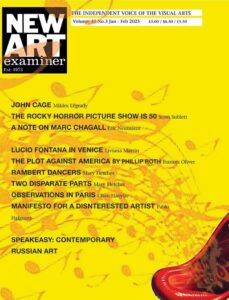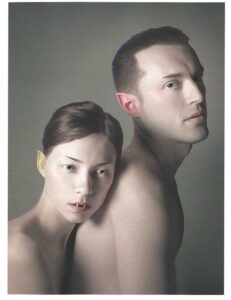Darren Jones
At the end of 2020, San Antonio-based artist Sarah Fox, was invited to participate in an exhibition titled “8 Create” at the city’s McNay Art Museum. Fox and seven fellow-invitees were given latitude to respond to work from Marion Koogler McNay’s founding bequest, and to consider “place” in relation to the museum, which incorporates the Spanish Colonial Revival mansion that was McNay’s home. It was a thrilling prospect for Fox, who had felt a kinship with the institution since she relocated to the city in 2011. She selected an etching, Frau mit übereinandergelegten Händen (Woman with Crossed Hands) 1898-1899, by Käthe Kollwitz (1867-1945), the German painter and printmaker who chronicled the dignity and plight of the working-classes. Fox began work on her response. The show is due to open on March 17th, but Fox’s work will now not be included—a decision that was confirmed by the McNay on February 11th.

An understanding of the artist’s oeuvre is necessary. Fox is motivated by gendered orthodoxies; the subjugation, labor and value of women; and the provenance of their bodies. In various media—animation, puppetry, drawing, cyanotypes—she has developed a cavalcade of anthropomorphized animals and mythic beings that weep, love, nurture and mourn through the pleasures, fucksploits, and horrors of life.

Her videos of these creatures in puppet form can be particularly emotive, yet there is humor too, in the whimsical props, rickety movements, and recognizable behavioral tropes—sex, slovenliness, intoxication. One might smile at some of the shenanigans, but it slowly fades at the pain her characters are living out in their Grimm settings or pastoral tableaux, as they roam the internet, masturbate, piss on Texas’ state flower (Bluebonnets) or drink themselves into lonely slumber. Fox has engineered a planetary collision between The Sensual World of Kate Bush and The Dark Crystal’s Thra, with a glancing blow from the realm of xHamster. Undergirding the work is what might be described as the lividness of womanhood.

The Great Cry (2018) is a stop-animation of Wagnerian heartbreak. A naked, female rabbit, looking almost skinned—red-raw, bloodied knees, patchy white tufts—sits on the edge of a floral-fringed pond. She silently wails and convulses in anguish, while her flitting plasticine expressions suggest unendurable torment. An orchestral soundtrack of plucks and almost-utterances translates her fractured state of mind, as does the thunderous sky behind her. Toward the end, she disembowels herself, moulds an infant from her viscera, then buries her progeny back within her womb, holding together the torn flesh of her abdomen like a ragged coat of gore. The dolorous impact is far beyond anything Narcissus could have imagined.

Bad Bunny (2021), the video that was intended for the McNay show, opens with another doe-marionette, dressed in a silky slip. She’s relaxing in a chair, smoking, checking a hook-up app (to swiping and pinging sounds) and sipping liquor, all with clumsy gestures. Brassy, jazz music accompanies her saucy movements which include a hare-raising Basic Instinct moment when the camera pans in on her uncrossing legs.
Her date is a dashing blue fox, who we first see brushing his teeth to an upbeat swing track à la John Williams’ “Mad About Me”. A quick cut to the rabbit (also getting ready) switches to the artist herself in pink masquerade eye-mask and long claw-like gloves. She’s looking off-camera, applying lipstick and mascara in imitation of the rabbit’s preparations. The fox, checks his look in the mirror and zips his pants, confident of his vulpine allure.
At a restaurant dinner—the fox has ordered raw steak; the rabbit, a dainty salad—sultry, 50s, saxophone music plays over background chatter. Wine flows—and spills. Later, the soundtrack grows darker and the inebriated cottontail suddenly rushes the table and consumes the fox’s meal in violent, snarling ecstasy as he looks on, horrified.

Again, we see the artist replicating our lagomorph heroine by tearing into her own piece of uncooked meat, before dabbing her mouth with a napkin. The bloodied dining room vignette ends calmly, our now amorous protagonists back in their chairs, tenderly stroking hands.
Later still, couch-canoodling and delighted squeals give way to sexual abandon—sounds of ripping fabric, exposed breasts, a Scooby-Doo howl, ass-slapping and a “boinging” erection—until the mood, once more, shifts ominously. The rabbit stands, and lunges at her mate’s head and throat, accompanied by catty growling.
The artist-doppelgänger is shown—smeared with glittery, silver liquid that she’s relishing. Her head bows out of the shot. The rabbit steps away from her quarry—both are spattered in the metallic goo. The fox staggers up, groans and clatters to the floor in a heap. She sits, exhales a satisfied sigh, crosses her legs, and lights a cigarette. In the artist’s final appearance she puffs on her own smoke, and slowly respires with a look of exacted vengeance.

The climax is a killing (literal or otherwise) that also implies sexual crescendo. The artist dipping out of sight, could be the downward gesture of continued attack—or fellatio; the eruption of starry splatulence could be blood—or semen; and the fox lying naked and immobile over his sodden shorts could be expired—or just knackered. The use of color stereotypes such as blue for boys and pink for girls; flesh for the guy, lettuce for the lady; and the visible puppetry strings—a brutal euphemism for male-domination—subtly set-up the role-reversal of predatory instincts.
On February 1st, the artist presented the rough-edit to the museum’s curatorial team. Concerns were raised over the video’s content, and during the following ten days, there were further discussions which ultimately proved fruitless. The museum has stated: “The video by Sarah Fox created for the exhibition does not adhere to the exhibition’s focus on our founder, Marion McNay, her original bequest, and her home and grounds. The artist’s decision to diverge from the show’s original thesis—and subsequent refusal to work with the Museum’s Curatorial team on realigning with the exhibition focus—is not in step with the McNay’s co-collaboration process. The exhibition’s curatorial team invited the artist to submit alternative work, to which the artist declined.”
In several communications with this writer, the museum cleaved ever closer to its reasoning, while conceding that the curatorial team was aware of the carnal nature of Fox’s earlier work, and that the new work’s sexual elements were problematic, but again, only “because it contributed to the artist’s choice to deviate from the exhibition’s curatorial thesis, from the work presented to the curatorial team prior to February 1, and from the connection to the work in the McNay’s collection the artist chose to respond to.”
It’s tricky then, that Fox was quoted previously, in the McNay’s own Impressions newsletter in reference to “8 Create”: “In a surreal puppet show, I use humor, sexuality, and rage to push back against the policing and politicization of women’s bodies”. Further, the artist holds that the curatorial team had also seen erotic drawings, and the fox’s working penis at progress meetings in 2021, and that she had been encouraged to continue in the mode she had proposed earlier. The popular belief in San Antonio’s art community is that it was potential viewer offense at the film’s sexual content which compelled the museum’s reaction, and that Fox’s absence from the show amounts to censorship.

If we accept the museum’s position momentarily—especially the claim that the Kollwitz etching exemplifies it—how does that hold-up?
The forlorn subject in Frau mit übereinandergelegten Händen, avoids the viewer’s gaze, looking to her left and slightly downward—a despondent mien. She is utterly alone, placed within a tight, claustrophobic frame and half-lost in shadows. The wall behind her is empty, affording no personal commentary. She has a swollen belly across which her hands rest. It could be distended from sickness; she could be pregnant (even in phantom form, if she had been denied that joy previously); she could be overweight, from poor nutrition, and poverty; or her portliness could be metaphorical—a manifestation of the trauma that women have carried for millennia. Any such aspects may have resonated with Fox—a working mother to a four-year-old boy. In her hands, the Kollwitz piece can be considered a clarion from the past, an echo of women’s lack of self-determination and wellbeing, now oriented toward future justness. Fox has drawn from Kollwitz’s melancholy subject, and created a message of empowerment, just as the patriarchal edifice seems to be crumbling.
The artist’s choice could hardly be more conducive for her concerns or the exhibition’s theme. One might ask, not only how a museum can assert that an artist’s origin point for a project was in essence, wrong, but how unnerving it is to claim such authority over an individual’s intellectual and emotional catalyst, particularly for as nebulous a concept as “place” regarding a collection and museum founded by a woman.

The exhibition will open with (at the time of writing) only two of the original artists. Several have withdrawn in protest, and plans are afoot for the artists to show their work, unedited, at another San Antonio institution. Additionally, the exhibition’s theme has been “reimagined” to have an “even greater” focus on Marion Koogler McNay. Although, confusingly, it was also noted that it would remain pretty much as it is. One wonders how much more about its founder the exhibition can be. It’s already her house, her taste, her name, her money, her legacy and apparently the conservatism of her era.
Generally speaking, for anyone to be perturbed at potential reactions to a wooden rabbit in coitus with a grinning fox-doll, would be almost comical. But not in Texas, where a fascistic legislature endangers the lives of children, women, parents, Queer, Black and Brown residents, every day. Whether or not the sexual content is a part, or all, of the museum’s discomfort, or if it was entirely about the theme, was it worth silencing a female artist who is pushing for visibility and fundamental protections in a place where they are being dismantled?
One concern is that even a hint of public belief that sexual visuals caused the work’s removal, allied with the museum’s guard-railing of thematic interpretation, could unwittingly embolden right-wing cultural or religious belligerents; constituencies that have always sought to crush artistic dissent for political capital. Museums in America are powerful institutions with the means to defend democracy, even if it costs Republican dollars. The McNay is, whether it likes it or not, in the vanguard by virtue of its geographic location. Seeking shelter under Marion McNay’s skirts benefits only regressive factions.

The McNay is a marvelous institution, with a dedicated team that has supported and continues to support, local artists. It will do so again. But in this instance, for the trail-blazing first museum of modern art in Texas to come in last, is disheartening. Fox and many of her state-based peers are working in defense of freedoms that liberal states can largely rely on (for now), just as anti-abortion and anti-Trans initiatives, and racist gerrymandering accelerate. If there is obscenity here, it isn’t in Fox’s imagery, nor her supposed straying from an exhibition theme—it’s that the video will not be seen on its intended and prestigious stage. For as long as art museums fail to consider larger contexts, and sail on in blinkered folly like so many institutional Titanics, the resolution of causes vital to equitable society will take longer to achieve. When artists are displaying courage enough to advance, museums must risk the trenches alongside them.

